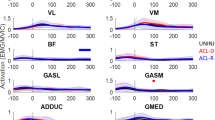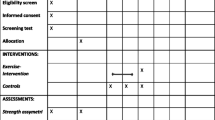Abstract
Purpose
To determine clinical and neuromuscular properties in patients with normal or sub-normal subjective knee function after finalisation of 6 months’ post-operative rehabilitation following anterior cruciate ligament reconstruction (ACLR).
Methods
Sixty patients after primary anatomical single-bundle hamstring ACLR were prospectively enrolled. Demographics, subjective, clinical and functional status of the injured knee were recorded at baseline, 6 and 12 months post-operatively. Return to pre-injury activities time (months) was monitored. Tensiomyography and isokinetic dynamometry of thigh muscles were performed at 6 months, when standard ACLR rehabilitation is finalized. Based on their IKDC Subjective Knee Evaluation scores at 6 months, they were assigned into “Normal” or “Sub-normal” group. All the above measured parameters were then compared between the two groups.
Results
At 6 months’ timeline, 21 patients (35%) perceived their knee function as “Normal”, while 39 (65%) were “Sub-normal”. There were no differences in clinical status between both groups, but patients in Normal group achieved higher IKDC, Lysholm, Tegner scores as well as higher single-leg hop test. They were taller, had lower body mass index and more of them achieved their preinjury level of activity at 12 months (67% vs. 33%). Tensiomyography revealed higher biceps femoris as well as semitendinosus and semimembranosus radial displacement values on the operated leg in Normal group. Isokinetic dynamometry showed significantly higher normalised peak torque and average power of knee extensor muscles.
Conclusions
Patients who perceive their knee function as normal at 6 months following ACLR presented with better neuromuscular properties of the thigh muscles. Decreased hamstring stiffness seems to be the key to higher return-to-preinjury activity. Postoperative rehabilitation should be more focused on reducing hamstring stiffness in addition to improving knee extensor muscle strength.
Level of evidence II (prospective cohort study).

Similar content being viewed by others
References
Murray MM, Vavken P, Fleming BC (2013) The ACL handbook. Springer, New York
Mehl J, Otto A, Baldino JB et al (2019) The ACL-deficient knee and the prevalence of meniscus and cartilage lesions: a systematic review and meta-analysis (CRD42017076897). Arch Orthop Trauma Surg 139:819–841
Wright RW, Dunn WR, Amendola A et al (2007) Risk of tearing the intact anterior cruciate ligament in the contralateral knee and rupturing the anterior cruciate ligament graft during the first 2 years after anterior cruciate ligament reconstruction: a prospective MOON cohort study. Am J Sports Med 35(7):1131–1134
Logerstedt D, Di Stasi S, Grindem H et al (2014) Self-reported knee function can identify athletes who fail return-to-activity criteria up to 1 year after anterior cruciate ligament reconstruction: a delaware-oslo ACL cohort study. J Orthop Sports Phys Ther 44(12):914–923
Ardern CL, Webster KE, Taylor NF, Feller JA (2011) Return to the preinjury level of competitive sport after anterior cruciate ligament reconstruction surgery: two-thirds of patients have not returned by 12 months after surgery. Am J Sports Med 39(3):538–543
Ayeni OR, Chahal M, Tran MN, Sprague S (2012) Pivot shift as an outcome measure for ACL reconstruction: a systematic review. Knee Surg Sports Traumatol Arthrosc 20(4):767–777
Thomas AC, Wojtys EM, Brandon C, Palmieri-Smith RM (2016) Muscle atrophy contributes to quadriceps weakness after anterior cruciate ligament reconstruction. J Sci Med Sport 19(1):7–11
Bryant AL, Kelly J, Hohmann E (2008) Neuromuscular adaptations and correlates of knee functionality following ACL reconstruction. J Orthop Res 26(1):126–135
Nomura Y, Kuramochi R, Fukubayashi T (2015) Evaluation of hamstring muscle strength and morphology after anterior cruciate ligament reconstruction. Scand J Med Sci Sports 25(3):301–307
Maeda N, Urabe Y, Tsutsumi S et al (2018) Symmetry tensiomyographic neuromuscular response after chronic anterior cruciate ligament (ACL) reconstruction. Knee Surg Sports Traumatol Arthrosc 26(2):411–417
Alvarez-Diaz P, Alentorn-Geli E, Ramon S et al (2016) Effects of anterior cruciate ligament injury on neuromuscular tensiomyographic characteristics of the lower extremity in competitive male soccer players. Knee Surg Sports Traumatol Arthrosc 24(7):2264–2270
Macgregor LJ, Hunter AM, Orizio C et al (2018) Assessment of skeletal muscle contractile properties by radial displacement: the case for tensiomyography. Sports Med 48(7):1607–1620
Sajovic M, Stropnik D, Skaza K (2018) Long-term comparison of semitendinosus and gracilis tendon versus patellar tendon autografts for anterior cruciate ligament reconstruction: a 17-year follow-up of a randomized controlled trial. Am J Sports Med 46(8):1800–1808
Pua Y-H, Bryant AL, Steele JR et al (2008) Isokinetic dynamometry in anterior cruciate ligament injury and reconstruction. Ann Acad Med Singapore 37(4):330–340
Taylor NA, Sanders RH, Howick EI, Stanley SN (1991) Static and dynamic assessment of the Biodex dynamometer. Eur J Appl Physiol 62:180–188
Rusu LD, Cosma GG, Cernaianu SM et al (2013) Tensiomyography method used for neuromuscular assessment of muscle training. J Neuroeng Rehabil 10(1):67–74
Alvarez-Diaz P, Alentorn-Geli E, Ramon S et al (2015) Effects of anterior cruciate ligament reconstruction on neuromuscular tensiomyographic characteristics of the lower extremity in competitive male soccer players. Knee Surg Sports Traumatol Arthrosc 23(11):3407–3413
Garcia-Garcia O (2019) Clinical utility of tensiomyography for muscle function analysis in athletes. Open Access J Sports Med 10:49–69
Alentorn-Geli E, Alvarez-Diaz P, Ramon S et al (2015) Assessment of neuromuscular risk factors for anterior cruciate ligament injury through tensiomyography in male soccer players. Knee Surg Sports Traumatol Arthrosc 23(9):2508–2513
Anderson AF, Irrgang JJ, Kocher MS et al (2006) The International Knee Documentation Committee subjective knee evaluation form: normative data. Am J Sports Med 34(1):128–135
Villa FD, Ricci M, Perdisa F et al (2016) Anterior cruciate ligament reconstruction and rehabilitation: predictors of functional outcome. Joints 3(4):179–185
Scherer JE, Moen MH, Weir A et al (2016) Factors associated with a more rapid recovery after anterior cruciate ligament reconstruction using multivariate analysis. Knee 23(1):121–126
De Valk EJ, Moen MH, Winters M et al (2013) Preoperative patient and injury factors of successful rehabilitation after anterior cruciate ligament reconstruction with single-bundle techniques. Arthroscopy 29(11):1879–1895
Spindler KP, Huston LJ, Wright RW et al (2011) The prognosis and predictors of sports function and activity at minimum 6 years after anterior cruciate ligament reconstruction: a population cohort study. Am J Sports Med 39(2):348–359
Nawasreh Z, Logerstedt D, Cummer K et al (2018) Functional performance 6 months after ACL reconstruction can predict return to participation in the same preinjury activity level 12 and 24 months after surgery. Br J Sports Med 52(6):375–375
Ardern CL, Taylor NF, Feller JA, Webster KE (2013) A systematic review of the psychological factors associated with returning to sport following injury. Br J Sports Med 47(17):1120–1126
Grindem H, Logerstedt D, Eitzen I et al (2011) Single-legged hop tests as predictors of self-reported knee function in nonoperatively treated individuals with anterior cruciate ligament injury. Am J Sports Med 39:2347–2354
Logerstedt D, Grindem H, Lynch A et al (2012) Single-legged hop tests as predictors of self-reported knee function after anterior cruciate ligament reconstruction: the Delaware-Oslo ACL cohort study. Am J Sports Med 40(10):2348–2356
Xergia SA, Pappas E, Zampeli F et al (2013) Asymmetries in functional hop tests, lower extremity kinematics, and isokinetic strength persist 6 to 9 months following anterior cruciate ligament reconstruction. J Orthop Sports Phys Ther 43:154–162
Perraton L, Clark R, Crossley K et al (2017) Impaired voluntary quadriceps force control following anterior cruciate ligament reconstruction: relationship with knee function. Knee Surg Sports Traumatol Arthrosc 25(5):1424–1431
Ingersoll CD, Grindstaff TL, Pietrosimone BG, Hart JM (2008) Neuromuscular consequences of anterior cruciate ligament injury. Clin Sports Med 27(3):383–404
Petersen W, Taheri P, Forkel P, Zantop T (2014) Return to play following ACL reconstruction: a systematic review about strength deficits. Arch Orthop Trauma Surg 134(10):1417–1428
Hiemstra LA, Webber S, MacDonald PB, Kriellaars DJ (2000) Knee strength deficits after hamstring tendon and patellar tendon anterior cruciate ligament reconstruction. Med Sci Sports Exerc 32(8):1472–1479
Thomas AC, Villwock M, Wojtys EM, Palmieri-Smith RM (2013) Lower extremity muscle strength after anterior cruciate ligament injury and reconstruction. J Athl Train 48(5):610–620
Ardern CL, Webster KE, Taylor NF, Feller JA (2010) Hamstring strength recovery after hamstring tendon harvest for anterior cruciate ligament reconstruction: a comparison between graft types. Arthroscopy 26(4):462–469
Nakamura N, Horibe S, Sasaki S et al (2002) Evaluation of active knee flexion and hamstring strength after anterior cruciate ligament reconstruction using hamstring tendons. Arthroscopy 18(6):598–602
Tashiro T, Kurosawa H, Kawakami A et al (2003) Influence of medial hamstring tendon harvest on knee flexor strength after anterior cruciate ligament reconstruction: a detailed evaluation with comparison of single-and double-tendon harvest. Am J Sports Med 31(4):521–529
Elmlinger BS, Nyland JA, Tillett ED (2006) Knee flexor function 2 years after anterior cruciate ligament reconstruction with semitendinosus-gracilis autografts. Arthroscopy 22(6):650–655
Hohmann E, Tetsworth K, Glatt V (2019) The hamstring/quadriceps ratio is an indicator of function in ACL-deficient, but not in ACL-reconstructed knees. Arch Orthop Trauma Surg 139:91–98
Kim H-J, Lee J-H, Ahn S-E et al (2016) Influence of anterior cruciate ligament tear on thigh muscle strength and hamstring-to-quadriceps ratio: a meta-analysis. PLoS One 11(1):e0146234. https://doi.org/10.1371/journal.pone.0146234
Author information
Authors and Affiliations
Corresponding author
Ethics declarations
Conflict of interest
The authors declare that they have no conflict of interest.
Additional information
Publisher's Note
Springer Nature remains neutral with regard to jurisdictional claims in published maps and institutional affiliations.
Rights and permissions
About this article
Cite this article
Stropnik, D., Sajovic, M., Kacin, A. et al. Early clinical and neuromuscular properties in patients with normal or sub-normal subjective knee function after anterior cruciate ligament reconstruction. Arch Orthop Trauma Surg 140, 1231–1239 (2020). https://doi.org/10.1007/s00402-020-03436-0
Received:
Published:
Issue Date:
DOI: https://doi.org/10.1007/s00402-020-03436-0




